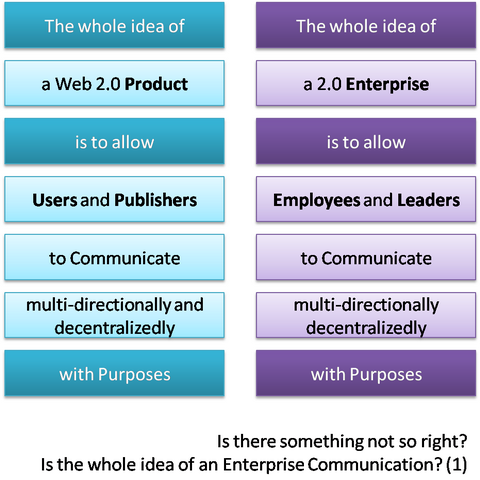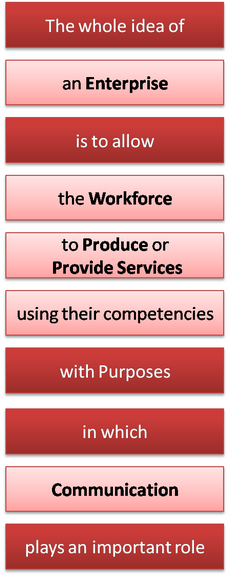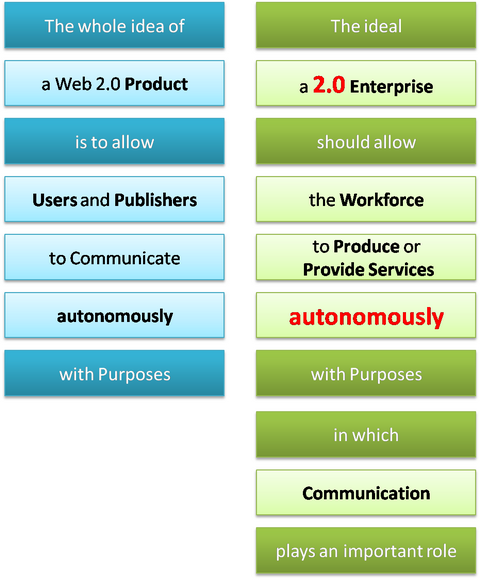1. Introduction
This article discusses implications behind the adoption of a “2.0″ approach to corporate management. This article is built on and extends the introductory discussion of an FPT HR representative on their application of 2.0 to internal communications. It seeks an equivalent position of the 2.0 characteristics within an organization. Basing on this finding, recommendations are given to FPT.
2. The position of the 2.0 characteristics
2a. Web 2.0 is about Communication. Is Enterprise 2.0 about Communication?
Basing on the comment from vanbich, the idea of FPT 2.0 is to provide channels and facilities for their employees to communicate with one another and with leaders.
At first, it seems sensible given light that a Web 2.0 product provides platforms for its users to communicate and share information with one another. And users do this with purposes.
Some examples of Web 2.0 products:
| Product | Effective communication channels | Purpose of product creators | Main purpose of users |
| WordPress |
| Provide a collaborative blogging platform | Share & aggregate knowledge |
|
| Explore connections’ activities | |
| MySpace |
| Provide means for people, especially artists, to show off their interests | Express their ego |
|
|
|
How are “2.0 communication” and FPT’s explanation linked together?
It’s useful to map the idea:

Figure 1 - trying mapping web 2.0 product and enterprise 2.0: incorrect
While we see that the total scale of a Web 2.0 product is allow Communication, the total scale of an Enterprise is much larger than that. We want to revise the ‘conventional’ enterprise:

Figure 2 - simplified model of a conventional enterprise
That is the full scale of an Enterprise. Communication plays an important role, but does not take up entirely its operations.
So how do we map it more precisely?
2b. Here is what I visual it: mapping between two 2.0 entities
Firstly, as we know that communication is the main activity of a Web 2.0 product, it is important to find out what is the main activity of an Enterprise. As from figure 2, the main activity of an enterprise is Production and/or Providing Services.
Secondly, it is important to characterize the style of communication in Web 2.0 products so that we can do the same on the style of production of an enterprise.
What best describes “multi-directional” and “decentralized”? It is autonomous. People in the 2.0 sphere communicate autonomously and are responsible for their behaviors.
Combining these two findings, here is what I propose the mapping between a Web 2.0 product and an Enterprise:

Figure 3 - mapping web 2.0 product and enterprise 2.0
3. Some considerations
- It’s easier for startups than for an established company.
Think about Google. It had been famous for its anti-corporate culture at the first days. As the company becomes mature, corporate issues start to emerge. - Does the structure of the company make it reasonable to build autonomous teams/divisions?
- Does the culture of the company and the culture of the society make it reasonable to build autonomous teams/divisions?
- How ready are the employees, in terms of capability and mentality, to be autonomous?
- Autonomous, together with self-directed communication is not new. It traces back to 1970s and Motorola, Xerox, AT&T and so on. However, it might be new to Vietnam.
4. Some recommendations for FPT toward 2.0
- Select mature teams to build autonomy
- Delayer these teams
- Allow (sometimes dramatic) changes in structure, culture and mentality
- Allow (sometimes dramatic) changes in personnel management and resource allocation
- Treat this as on-going experiment
Benefits:
- Bring the “2.0 spirit” to the company as leaders desire
- Increase innovation
- Reduce cost, especially management overhead
- Reduce absenteeism
- Identify unofficial leaders of the teams in addition to the existing leadership training program
5. Summary
Changes in production characteristics, rather than sheerly in communication, reflect the full-scale shift within an Enterprise. Analyzing Web 2.0 characteristics leads us to autonomy. Whether and how FPT will implement it is interesting to observe. The implications of recommendations in this article go beyond social media, product management and technology companies to leadership generally.
6. Reflection
It has been challenging and exciting to write this. The excitement was how I can link seemingly scattered parts of my knowledge to form a cohesion piece of consultation - something I love doing. The great challenge lies in the idea of evaluating a big, established, known and loved company. Nevertheless, if I want to learn, first thing first, I must dare the keyboard discussion.
Xem đầy đủ bài viết tại http://feedproxy.google.com/~r/TaiTran/~3/kv0MxWmO-FE/toward-enterprise-20-positioning-the-20-characteristics-in-an-enterprise-and-some-suggestions-for-fpt.html


No comments:
Post a Comment